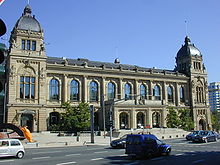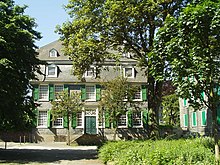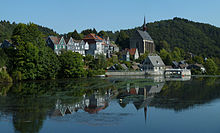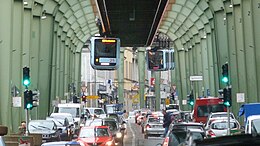Wuppertal | |
|---|---|
|
Clockwise from top: view over Wuppertal-Elberfeld, Wuppertal Suspension Railway running beneath Sonnborn Railway Bridge (Sonnborner Eisenbahnbrücke), St Lawrence's Basilica at dusk, the suspension railway running through the city, the suspension railway running above the Wupper, hilly cityscape at Friedrichstraße | |
| Coordinates: 51°16′N 07°11′E / 51.267°N 7.183°E | |
| Country | Germany |
| State | North Rhine-Westphalia |
| Admin. region | Düsseldorf |
| District | Urban district |
| Government | |
| • Lord mayor (2020–25) | Uwe Schneidewind[1] (Greens) |
| • Governing parties | Greens / CDU |
| Area | |
| • City | 168.41 km2 (65.02 sq mi) |
| Highest elevation | 350 m (1,150 ft) |
| Lowest elevation | 100 m (300 ft) |
| Population (2023-12-31)[2] | |
| • City | 358,938 |
| • Density | 2,100/km2 (5,500/sq mi) |
| • Urban | 608,000 (Bergisches Dreieck) |
| • Metro | 11,300,000 (Rhein-Ruhr) |
| Time zone | UTC+01:00 (CET) |
| • Summer (DST) | UTC+02:00 (CEST) |
| Postal codes | 42001-42399 |
| Dialling codes | 0202 |
| Vehicle registration | W |
| Website | wuppertal.de |








Wuppertal (German pronunciation: [ˈvʊpɐtaːl] ; lit. 'Wupper Dale') is a city in North Rhine-Westphalia, Germany, with a population of 355,000. Wuppertal is the seventh-largest city in North Rhine-Westphalia and 17th-largest in Germany. It was founded in 1929 by the merger of Elberfeld, Barmen, Ronsdorf, Cronenberg and Vohwinkel, and was initially called "Barmen-Elberfeld" before adopting its present name in 1930. It is the capital and largest city of the Bergisches Land.
The city straddles the densely populated banks of the River Wupper, a tributary of the Rhine. Wuppertal is located between the Ruhr (Essen) to the north, Düsseldorf to the west, and Cologne to the southwest, and over time has grown together with Solingen, Remscheid and Hagen. The stretching of the city in a long band along the narrow Wupper Valley leads to a spatial impression of Wuppertal being larger than it actually is. The city is known for its steep slopes, its woods and parks, and for being the greenest city in Germany, with two-thirds green space of the total municipal area. From any part of the city, it is only a ten-minute walk to one of the public parks or woodland paths.
The Wupper Valley was, along with the Ore Mountains and before the Ruhr, the first highly industrialized region of Germany, which resulted in the construction of the Wuppertal Schwebebahn suspension railway in the then independent cities of Elberfeld and Barmen. The increasing demand for coal from the textile mills and blacksmith shops from those cities encouraged the expansion of the nearby Ruhr. Wuppertal still is a major industrial centre, being home to industries such as textiles, metallurgy, chemicals, pharmaceuticals, electronics, automobiles, rubber, vehicles and printing equipment. Aspirin originates from Wuppertal, patented in 1897 by Bayer, as does the Vorwerk Kobold vacuum cleaner.[3][4] The Wuppertal Institute for Climate, Environment and Energy and the European Institute for International Economic Relations are located in the city.[5] Barmen was the birthplace of Friedrich Engels.
- ^ Wahlergebnisse in NRW Kommunalwahlen 2020, Land Nordrhein-Westfalen, accessed 19 June 2021.
- ^ "Bevölkerung der Gemeinden Nordrhein-Westfalens am 31. Dezember 2023 – Fortschreibung des Bevölkerungsstandes auf Basis des Zensus vom 9. Mai 2011" (in German). Landesbetrieb Information und Technik NRW. Retrieved 2024-06-20.
- ^ Marvin Brendel. "110 Jahre Aspirin" (in German). GeschichtsPuls. Retrieved May 22, 2011.
- ^ "Official website Vorwerk – Kobold vacuum cleaners". Archived from the original on February 21, 2013. Retrieved May 22, 2011.
- ^ "Official website European Institute for International Economic Relations". Retrieved March 2, 2013.










